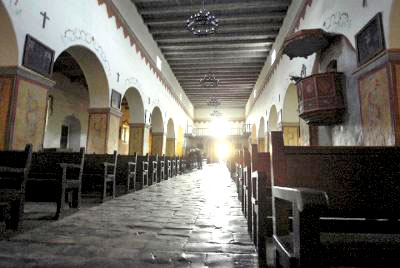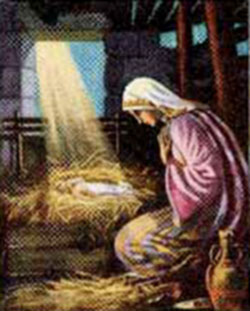|

by Acharya S
01 April 2011
from
FreeThoughtNation Website

Rays of light from
the rising sun on the winter solstice stream
into the chapel
through the front door and window at Mission San Juan Bautista.
(VERN FISHER/Herald
file)
One of the more important aspects of my
work is to bring to light the ancient religious practice of aligning
sacred sites with astronomical events, such as the daily, weekly,
monthly and annual movements and phases of the sun, moon and other
celestial bodies.
This practice dates back thousands of
years in countless archaeological sites globally, across a vast
diversity of cultures from numerous eras. Astronomically aligned
sacred sites can be found in so-called Pagan sites, as well as those
of the
Abrahamic religions, including Judaism, Christianity and
Islam.
The combination of the astronomical
alignments with sacred sites is expressed in what is called "astrotheology,"
which is most apparent in the myths of the various cultures who
built these monuments.
In the following news item appear yet more examples of this age-old
tradition, as found within Christianity in particular.
The fact that
winter-solstice alignments, for instance, are discovered at
Christian sites reflects that their architects and builders were
well aware of the significance of that date, originally the "birth"
of the year's new sun but observed for over 1,700 years as
"Christmas" or the purported birth of Jesus Christ.

It is clear that in marking this date
and celebrating this holiday, Christians were merely latching onto a
very ancient, astrotheological practice shared by numerous cultures
worldwide.
In addition, in some instances the summer-solstice rising sun
illuminates a statue or other image or representation of John the
Baptist, which is fitting since John's "birthday" has traditionally
been placed at that time, a reflection of his role as the
summer-to-winter sun, at which point he is replaced by Christ as the
winter-to-summer sun.
This transition is reflected in the
enigmatic biblical scripture at John 3:30:
"He must increase, but I must
decrease."
This correlation was obviously not lost
on those who placed John the Baptist's birthday on June 24th, the
traditional summer-solstice celebration in several cultures, as well
as the winter solstice in the southern hemisphere.
The fact is that one simply cannot
understand the origins of Christianity or much other religious
thought without knowing the
archaeoastronomy and astrotheology of
the ancients.
All efforts to develop a "biography" of
Jesus Christ or an early Church history will fail without factoring
in this vast and profound context of ancient astrotheology, which
permeated the area in which the Christian effort took place,
expressed abundantly in the religions of ancient Greece, Rome, Egypt
and India, to name a few examples.
Unfortunately, few biblical scholars are
well versed in these important subjects and are therefore missing a
huge piece of the puzzle.
Illuminating research
CSU Monterey Bay
archaeologist studies rare light effects at missions
Ruben G. Mendoza is on a
quest for light.
The 54-year old archaeologist and professor of Social and
Behavioral Sciences at CSU Monterey Bay is seeking the rarest of
lights:
Early morning rays of the
solstice sun, channeled by a centuries-old alchemy of
architecture and astronomy, geometry and awe, into brilliant
tabernacle illuminations at California's missions.
It's a complex blend of solar
geometry and Franciscan cosmology, says Mendoza, in which
churches, windows and altars were laid out in relation to the
sun's position on a particular day of the year.
Illuminations occur on solstice, equinox or feast day mornings,
says Mendoza, with light entering through a particular window
and illuminating the tabernacle or an altar bulto, or statue, of
a saint in a brilliant column of light.
At Carmel, Mendoza describes the June 21 phenomenon as an
intense beam which crosses the nave, pulses across the altar,
then drops at an angle to rest squarely on the Eucharistic
tabernacle, the sacred receptacle that holds the host, believed
by the faithful to undergo transubstantiation during Mass to
become the body of Christ.
"It's so exciting to see the
excitement of the community when they see it," Mendoza says.
"It's like a rebirth."
At Mission San Miguel, parishioners
moved by the sight of the illumination of St. Francis burst into
shouts of "hallelujah," says Mendoza.
Documenting illuminations
Mendoza has overseen archaeological
undertakings at Mission San Juan Bautista and Carmel Mission,
headed archaeology and conservation efforts at San Carlos
Cathedral in Monterey and is leading archaeological digs at
Mission Soledad in hopes of ensuring its eventual restoration.
And, so far, he has documented
illuminations at 14 of California's 21 missions.
In 2003, Mendoza captured the summer solstice tabernacle
illumination at Carmel Mission after several years of efforts.
The winter solstice illumination of the Royal Presidio Chapel of
Santa Barbara took four years because of rain, fog, illness and
a scheduled out-of-state conference. After a three-day delay
because of cloud cover, he finally recorded it in December
2008...
There's nothing accidental about them: Carmel, San Juan Bautista
and the other missions with illuminations were built on a
meridian, an architectural orientation to the sunrise of a
particular day.
The complex solar geometry of the missions is less surprising,
says Mendoza, given that the missions were built in the era of a
maritime economy, where celestial navigation was a common skill,
and the fact that European churches were often built on
meridians.
"If we go back to the medieval
era, we know that the churches of Italy would be laid out in
such a way that they would plant a post in the ground on the
feast of a particular day, wait for the sun to rise and it
would cast a shadow," says Mendoza.
"Then the friars would tie a
rope and drag it along the shadow and build the church along
that alignment."
Seen in Carmel
The pastor at Mission San
Juan Bautista first pointed out an illumination to Mendoza on
Dec. 21, 1997, the morning of the winter solstice. Mendoza was
skeptical that San Juan Bautista was unique and started
searching for similar occurrences at churches across the U.S.,
Central America and Mexico.
In 2003, when he witnessed the summer solstice illumination at
Carmel Mission, he could see the start of a pattern.
"Once I discovered it at
Carmel," he said, "I realized it could not be a coincidence
in a diocese with seven missions."
At Mission San Miguel, illuminations
occur as progressions in five-day intervals, beginning with the
Oct. 4 illumination of the statue of St. Francis, the
illumination of the tabernacle, the statue of St. Michael the
Archangel, and the statue of St. Anthony on Oct. 19.
"Significantly, immediately
above St. Anthony's head is the painted image of the
stigmata with the five wounds of Christ. The five-day
intervals, I believe, bear direct reference to this sacred
numerology," says Mendoza.
The pattern at the mission is
reversed at the vernal equinox, says Mendoza, when the
illuminations begin with St. Anthony and end with St. Francis.
"That, for me, is one of the
most complex solar geometries that I've seen at any of the
California missions," says Mendoza.
Spring equinox illuminations at
Santa Ines and San Jose missions are repeated Sept. 21, the
second equinox of the year.
At Mission San Luis Rey, says
Mendoza, a lantern affixed to the cupola projects a Trinitarian
illumination, where three spears of light project onto the
altar.
Mission Santa Clara would also exhibit a summer solstice
illumination, he says, if its essential window hadn't been
blocked during reconstruction...
As for Mendoza, a sense of wonder continues, even after years of
research.
And he has plenty left to wonder about. More than 100,000
churches were built in Mexico alone during the mission period,
says Mendoza, along with countless churches across the
Southwest.
"For me, this is an unfinished
agenda," he says. "These sites are fascinating, but we've
only begun to scratch the surface."
Mendoza is working on a book on
archeoastronomy in the Americas....
|


